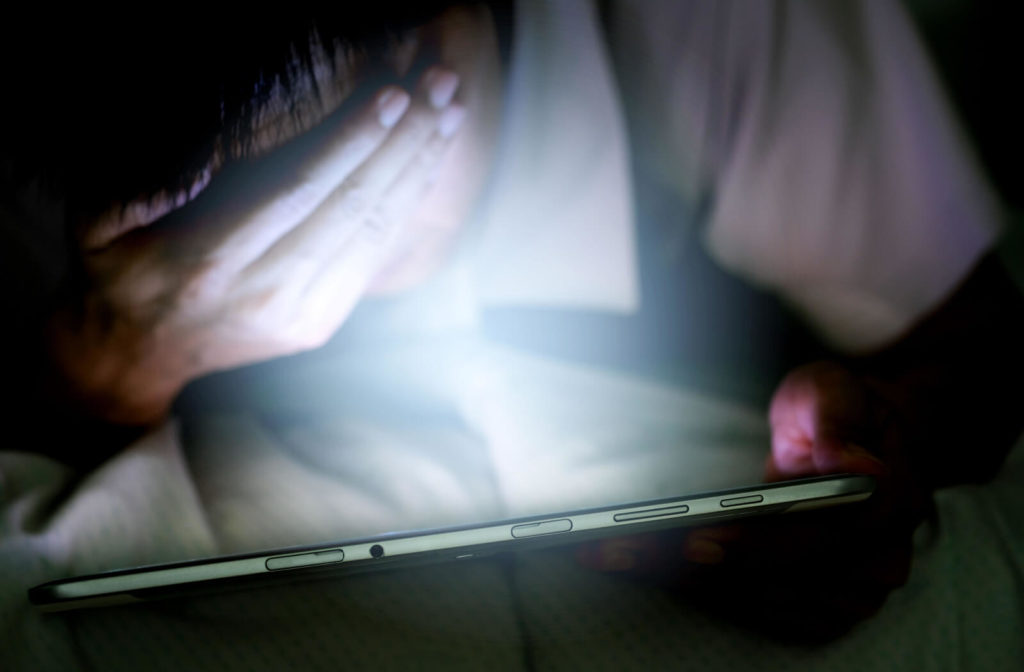Blue light glasses are gaining popularity for those struggling with digital eye strain symptoms. As phones, computers, and tablets dominate schools, workplaces, and homes, choosing a pair of glasses that can filter out their blue light could be a great solution.
Can blue light glasses help with digital eye strain? Blue light glasses are regular lenses with a coating to block blue light and don’t harm your eyes or alter your vision, so you can wear them all day if you choose. Understanding what blue light is and how it can affect your vision is the first step in deciding whether blue light glasses could be right for you.
What Is Blue Light?
All light falls on a spectrum of color, and the length of visible light waves ranges from violet light’s 380 nanometers to red light’s 700 nanometers. Blue light waves are faster, shorter, and high energy, only slightly less powerful than UV light.
Blue light comes through screens on your devices, but it also emanates from fluorescent bulbs, LEDs, incandescent lights, and the sun.
Research on blue light is still in progress, but evidence shows blue light may confuse your brain—blue light signals to your brain that it’s daytime and can cause alertness when your brain should be winding down to sleep.
Blue light may inhibit your natural ability to produce melatonin, the sleep hormone. Preliminary evidence indicates that blue light affects your circadian rhythm, or your internal clock, and may impact your sleep cycle.

Digital Eye Strain
Blue light may be a cause for concern because of its impact on eye health. As screen usage increases, cases of digital eye strain become more common. Digital eye strain is estimated to affect as many as 50% of all computer users.
Blue light glasses are popular for their supposed ability to reduce blue light-induced eye strain. Digital eye strain is a condition typically resulting from screen and computer-focused tasks. Symptoms can include:
- Blurry vision
- Dry eyes
- Watery eyes
- Headaches
- Stiff neck, back, or shoulders
- Eye fatigue
- Light sensitivity
Can You Wear Blue Light Glasses All Day?
Blue light glasses, which aim to block the blue light waves, claim to improve sleep and reduce digital eye strain. Wearing blue light glasses isn’t harmful to your eyes, so you could wear them all day if you wanted, but it may not eliminate digital eye strain entirely.
Digital eye strain may not be caused by blue light. While your devices can lead to eye strain, it’s not clear whether blue light plays a role in this.
Causes of Digital Eye Strain
Research indicates that people using digital devices for long periods tend to blink less than average, leading to less moisture. The time spent in front of the screen without breaks also contributes to symptoms of digital eye strain.
The angles of your screen, posture, and distance from your screen are critical for minimizing digital eye strain symptoms. Eye focusing and eye movement requirements can place demands on your vision unique to computer work. Digital eye strain can also be worsened by uncorrected vision problems, such as myopia, hyperopia, astigmatism, or presbyopia. With presbyopia, you may have to move your head in uncomfortable ways to accommodate.
To date, there’s no clear evidence to suggest that the small amount of blue light you’re exposed to from screens will harm your eyes. While preliminary animal studies indicate that there may be a link between age-related macular degeneration (AMD) and blue light exposure, it’s not yet clear what the link is between blue light and retinal damage or AMD.
Blue light glasses may help filter out blue light waves, but digital eye strain can also be relieved with other digital habits.
How to Relieve Digital Eye Strain
You can lessen symptoms of digital eye strain with some proven solutions. If your symptoms are getting in the way of your life and causing severe discomfort or pain, see your optometrist for a comprehensive eye exam to assess the health of your eyes.
Blinking
Insufficient blinking can lead to symptoms of digital eye strain, such as dry eye and eye fatigue. In typical conditions, people blink about 15–20 times per minute. However, when using your digital devices, you only blink 5–7 times per minute. When you don’t blink enough, your eyes aren’t lubricated effectively, causing discomfort. To overcome digital eye strain, try to blink more often to rehydrate your eyes.
Use Artificial Tears
Artificial tears are a simple way to add moisture back to your eyes. Artificial tears are safe and effective, but you should consult your optometrist before putting any product in your eyes.
The 20-20-20 Rule
Following the 20-20-20 rule allows your eyes to rest throughout screen tasks. Every 20 minutes, shift your eyes to look at something 20 feet away for at least 20 seconds. This exercise will help pull you out of hyper-focusing on your screen.
Keep a Distance from Your Screen
Developing bad posture, leaning into screens, or holding your devices too close can lead to headaches and muscle tightness. Maintaining a distance of 25 inches or an arm’s length between you and your devices can help reduce strain on your body.
Adjust Brightness
As the light conditions change throughout the day, your screen’s brightness and contrast should change too. Some newer devices auto-adjust and turn on dark mode or night shift. You can dim the brightness and switch the contrast to warmer light so your e-reader, tablet, computer, or phone doesn’t aggravate your eyes as the sun sets.
Wear Computer Glasses
Computer glasses aren’t the same as blue light glasses. Computer glasses allow wearers to focus on the computer screen, and the whole lens focuses on the same distance. It reduces the need to tilt or shift your head to see the screen clearly.
For those with presbyopia, an age-related vision change characterized by the inability to focus on close objects, computer glasses can be a tremendous help. If you work in an office or use devices for long periods, you may want to discuss computer glasses with your optometrist to determine if they would be beneficial.
Customize Your Lenses
Let our team help you find the best digital eye strain solution for your eyes—Contact Dr. Jennifer L. Shane & Associates to schedule an appointment to assess your eye health.



